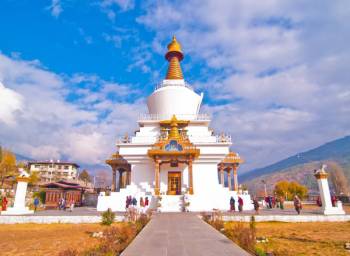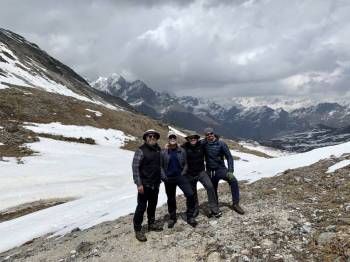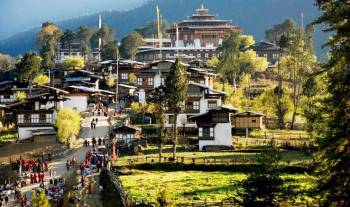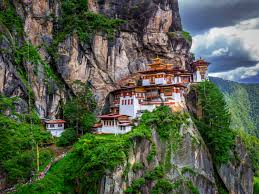7 Days Thimphu Tshechu Package
Duration : 6 Nights / 7 Days
Destination Covered : Thimphu, Paro, Punakha
Tour Activities : Museums, Sightseeing
Tour Themes : Hill Stations & Valleys, Religious & Pilgrimage, Culture & Heritage
Price on Request
Thimphu, Paro and Punakha Tour Overview
Thimphu Tshechu Festival is one of the most popular festivals in Bhutan. This festival is held in Thimphu for 3 days beginning on 10th day of the 8th month of lunar calendar usually held in the end of September or beginning of October. Unlike in other Tshechu, a day before Thimphu Tshechu is celebrated as Lhamo Dromchoe dedicated to Lhamo Dudsolma or Palden Lhamo, one of the chief protective deities of Bhutan. The three days Thimphu Tshechu honors Guru Rinpoche, Padmasambhava and was initiated by the 4th Desi, Gyalse Tenzin Rabgay in 1,867 AD. This Thimphu festival is witnessed by thousands of people from all over Bhutan. The actual Tshechu is preceded by days and nights of prayer and rituals to invoke the Gods. To Bhutanese farmers, the Thimphu Tshechu is also seen as a break from farm life. It is an annual social gathering where people dress in their finest clothing and jewelries come to celebrate, receive blessings and pray for health and happiness.
Arrival / Departure
Arrival: Paro International Airport
Departure: Paro International Airport
Thimphu, Paro and Punakha Tour Itinerary
Tachog Lhakhang: On the way, halt at Tachog Lhakhang (Bhutan first Iron Bridge) for sightseeing and photography. Upon reaching Thimphu, check in to the hotel and let’s have your first taste of Bhutanese cuisine and some light sightseeing in Thimphu if possible.
Folk Heritage Museum: Dedicated to connecting people to the Bhutanese rural past though exhibition of artifacts used in rural households.
National Memorial Chorten: The Memorial Stupa, Thimphu, also known as the Thimphu Chorten, is a stupa (Dzongkha chöten, cheten) in Thimphu, Bhutan. The stupa, built in 1974 to honor the third Druk Gyalpo, Jigme Dorji Wangchuck (1928–1972), is a prominent landmark in the city with its golden spires and bells.
Thimphu Dzong (Tashicho Dzong) Night View: Located at the capital city of Bhutan, The Tashichho Dzong is the office of the King of Bhutan. It also serves as the office of the Central Monastic Body. It houses hundreds of monks and holy stupas. Visit to this dzong is open after 5 PM. The Night view of the dzong is marvelous.
Thimphu Tshechu: As all Tshechu festivals, honors Padma Sambhawa, also known as Guru Rimpoche, the precious yogi and saint who is credited with having introduced Tantric Buddhism throughout the Himalayas. The festival’s masked dances are performed by monks clad in colorful brocade attire and permeated by chants and reading of Buddhist scripts. The culmination of festival constitutes the unfolding of a huge cloth thanka, a sacred scroll, depicting Padma Smabhawa and imagery from Buddhist pantheon.
Buddha Point– Located at Kuensel Phodrang, the 169 feet bronze statue of Buddha Dordenma, Vajra Throne Buddha symbolising indestructibility will be completed soon. The Buddha statue itself is competed awaiting paintings, but visitors can drive up to the Buddha point and view the tallest statue of Lord Buddha. The view of Thimphu valley from the Buddha point is spectacular and beautiful, especially at night.
Craft Bazar/ Mark: A one stop place to witness Bhutanese culture and buy Bhutan made arts and crafts product. The Bazar has approximately 80 stalls covering all aspects of the traditional arts and crafts of Bhutan. At this Bazzar, craftsmen and artisans from across the county display and sell their handicrafts.
Thimphu Tshechu: As all Tshechu festivals, honors Padma Sambhawa, also known as Guru Rimpoche, the precious yogi and saint who is credited with having introduced Tantric Buddhism throughout the Himalayas. The festival’s masked dances are performed by monks clad in colorful brocade attire and permeated by chants and reading of Buddhist scripts. The culmination of festival constitutes the unfolding of a huge cloth thanka, a sacred scroll, depicting Padma Smabhawa and imagery from Buddhist pantheon.
Craft Bazar/ Mark: A one stop place to witness Bhutanese culture and buy Bhutan made arts and crafts product. The Bazar has approximately 80 stalls covering all aspects of the traditional arts and crafts of Bhutan. At this Bazzar, craftsmen and artisans from across the county display and sell their handicrafts.
Dochu-la Pass: We will stop at Dochu-la Pass, here we see 108 chortens built by the present Queen mother of Bhutan Ashi Dorji Wangmo Wangchuk to commemorate Bhutan’s victory over Indian militants and to liberate the souls of people who lost their lives. Continue through the bustling market town of Wangduephodrang, and up winding mountain roads through mixed forests and over high passes before ascending into the wide and picturesque Phobjikha Valley. Phobjikha is one of Bhutan’s few glacial valleys, and chosen winter home of black necked cranes (November – March) migrating from the Tibetan plateau. Upon reaching Phubjikha, walk around the valley and visit crane center & Gantay Monastery.
On the way we will stop at Chhimi Lhakhang – A 20 minutes’ walk across terraced fields through the village of Sopsokha. Ngawang Chogyel built the temple in 15th century after the ’divine Madman’ Drukpa Kuenlay built a small chorten there.
Upon reaching Punakha, we will visit following places:
Punakha fort (Dzong): which was old Capital of Bhutan and observe the stunning view and beauty of the fort.
Punakha Suspension Bridge: This bridge is one of the longest bridges in Bhutan which conntects People form Shengana, Samdingkha, and Wangkha villages across the Tsang Chu River (aka Po Chu) to Punakha DzongThe bridge offers a spectacular view of the river and valley, and the east bank is a good starting point for multi-day treks in the nearby mountains.
Khamsum Yulley Namgyal Chorten: Built by the third Queen Mother Ashi Tshering Yangdon wangchuck this Chorten is a splendid example of of the Bhutanese architecture and art and is the only one of its kind in the world. It has been built over eight and a half years and its details have been drawn from religious scripture.
Paro Dzong: This Dzong was built in 1644 by Shabdrung Ngawang Namgyal and today houses a Monastic school, the office of the local governor and few government offices. If you like, you can take a short walk downhill crossing a traditional cantilever bridge over the Pa-chu (Paro River) will take you to the base of the hill.
Ta Dzong/ National Museum: Built as a watchtower the Ta Dzong has since been turned into the national museum.
More Details about Thimphu, Paro and Punakha Tour
Inclusions
- Hotel
- Sightseeing
- Sustainable Development Fee (SDF – USD. 100/- per night per head). This directly goes to the Government for free Health and Education for the citizens of Bhutan.
- Visa fee of USD. 40/- per head.
- Tourism Council of Bhutan (TCB) Certified and Experience English Speaking personal Guide.
- Accommodation at 3 Star hotel with Shared Double/Twin bed room.
- SUV comfortable Vehicle for the whole tour including pickup, sightseeing and drop off.
- An experience driver.
- 3 meals a day (Breakfast, Lunch and Dinner) at designated restaurants and hotels.
- Standard Travel Insurance (only Bhutan).
- Monuments/ forts/ Dzongs entry fee and road permits.
- Bottled Mineral Water (500 ml) per head per day in the vehicle.
- 1 Local Tourist SIM – Complementary.
- All local royalty, fees and taxes.
- Free full assistance before, during and after your Bhutan trip.
Exclusions
- Flight Fares (domestic & internationals). However, Bhutan sector flight can be arranged with us).
- Additional/Extra room supplement and room upgrade.
- Bank charges for payment transfers. Card payment charges are higher than wire transfer.
- Tips for the guide and driver.
- Alcoholic drink.
- Anything which is not mentioned under inclusion are not included in the cost.
- Cancelation as per TCB rules.
- Additional sightseeing or extra usage of vehicle, other than mentioned in the itinerary.
- Any cost arising due to natural calamities like, landslides, road blockage, political disturbances (strikes), etc (to be borne by the client, directly payable on the spot).
Payments Terms
- * 20% Advance Percentage of total booking amount
Cancellation & Refund Policy
- * Upon cancellation, refund will be made after deducting the Retention Amount.


















